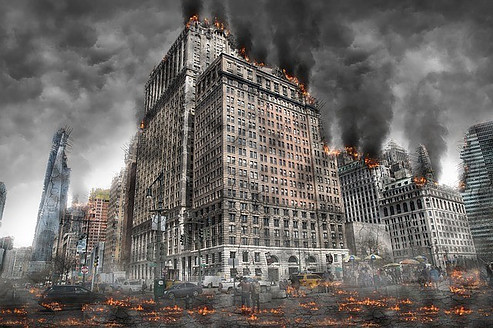
Unless stored in deep shelters or with special protection, all foodstuffs are likely to have been contaminated by some measure of radioactivity. Beware foods that contain a high level of salt, like milk, cheese and sea foods. Testing of foods after exposure to radiation found those with high salt and other additives had a higher concentration of radioactivity than foods without them. Cured and processed meats are more readily contaminated than fresh. Bone absorbs the highest levels of radioactivity, then lean meat and fat the lowest.
Water
Unless it is from a protected source, do not drink any water for at least 48 hours after detonation. Avoid water from lakes, pools, ponds and other static surface water. Filter all water and boil it before drinking.
The following sources are the least contaminated (in order of the least risk):
- Underground wells and springs
- Water in underground pipes and containers
- Snow taken from deep below the surface
- Fast-flowing rivers
Dig a hole by a fast-flowing stream and allow water to filter down into it. Scrape off any scum that forms on the surface and scoop up the water. Next, filter it through layers of sand and pebbles (you’ll have to dig deep to obtain these) in a can with holes punched in the bottom, or through a stocking. Then boil it in an uncontaminated vessel.
Decontaminate utensils by washing thoroughly in fast-flowing or boiled water.
Animals As Food
Animals that live underground will have less radiation exposure than those that live on the surface. Animals like rabbits, badgers, voles (small rodents) and similar animals are the best bets. However, when they venture out, they too will be contaminated. Nevertheless, such food sources must be utilized. You will increase your own contamination, but the alternative will likely be starvation, which will make your more susceptible to radiation side-effects.
To reduce contamination from meat, DO NOT directly handle carcasses. Wear gloves or use cloth to cover the hands while carefully skinning and washing. Avoid meat in direct contact with the bone. The skeleton retains 90 percent of the radiation so leave at least 3mm (1/8 in) on the bone. Muscle and fat are the safest part of the meat. Discard ALL internal organs.
Plants As Food
Root vegetables with edible tubers growing underground are safest – carrots, potatoes and turnips, for example. Wash them well and peel before cooking.
Smooth-skinned fruits and vegetables are the next safest. Plants with crinkly foliage are the hardest to decontaminate because of their rough texture. They should be avoided.
Long Term Survival
Predictions of the long-term results on the environment of a major thermonuclear conflict vary widely. The possibility of a “nuclear winter”, with its consequent effect on climate and plant life far beyond strike areas, would make even subsistence agriculture difficult. In the short term, however, and in the case of a limited conflict, the advice from the Make Camp / Home Front section will be relevant.
Shielding
Strictly speaking, it is impossible to completely shield yourself from all radiation, but a sufficient thickness of shelter material will reduce the radiation level to a negligible amount. Below are some materials, and the thickness required to reduce radiation penetration by 50%
| Material | Meters | Feet |
| Iron & Steel | 0.21 | 0.7 |
| Concrete | 0.66 | 2.2 |
| Brick | 0.60 | 2.0 |
| Soil | 1.00 | 3.3 |
| Ice | 2.00 | 6.6 |
| Wood | 2.60 | 8.8 |
| Snow | 6.00 | 20.3 |
Survival Advice
Fish and Aquatic animals will generally have a higher contamination level than land animals from the same area. Birds will be particularly heavily contaminated and should not be eaten. However, eggs are safe to eat. If available, the safest canned foods to eat are soups, vegetables and fruits.